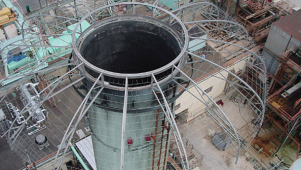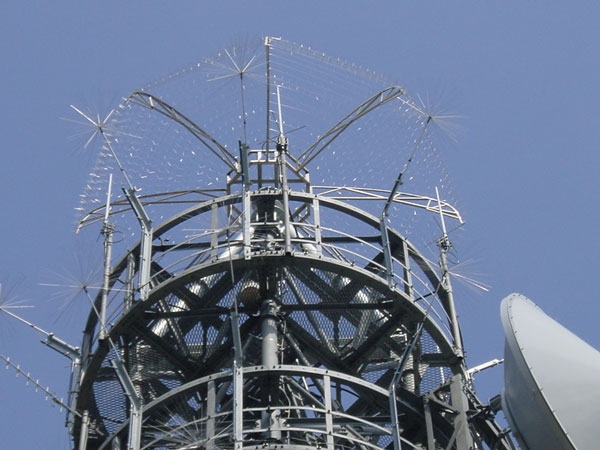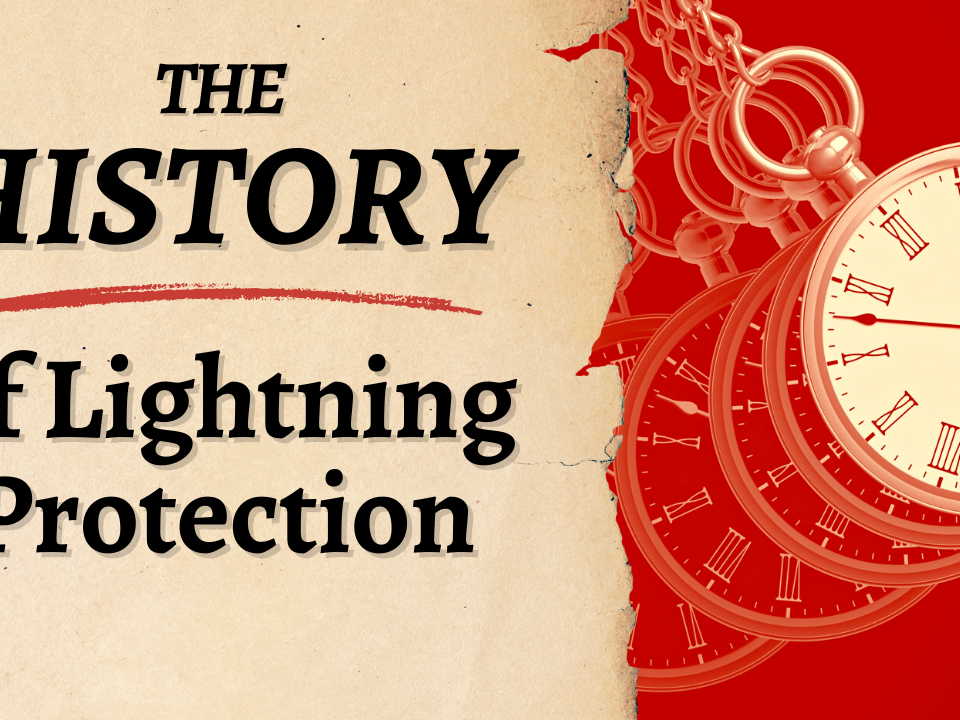- 100% AMERICAN MADE
- Lightning Protection - YOUR time, NOT Downtime

When Lightning Strikes
December 9, 2012
Container Shortage Delays One Exporter’s Shipments
December 20, 2012When Lightning Strikes

LEC Dissipation Array System (DAS) protecting an oil refinery
Lightning Strikes – It’s better when it doesn’t
When it comes to lightning, data centers, as well as all electronics and other mission-critical operations, face a fair amount of risk. In 2006, a Carnegie Mellon report found that 30 percent of businesses suffer damage from lightning storms. According to The Hartford, lightning is responsible for more than $5 billion in total annual insurance losses. It is also the third-largest cause of sustained outages in bulk power systems according to the American Electric Reliability Corporation. By Using Lightning Protection Systems We Can Prevent Lightning Strikes.
Thunderstorms thrive in warm weather, and with climate change, thunderstorm activity—and the damage it creates—is only getting worse. Both Lloyd’s and the Insurance Information Institute reported a 15 percent increase in lightning-related losses from 2009 to 2010. In the U.K., the Association of British Insurers expects weather damage, much of it lightning-related, to double by the year 2040.
Data centers are not in the dark about this threat. Most have the traditional means of lightning protection—conventional lightning rods also known as Franklin Rods—incorporated in their building design. Rods work by “collecting” lightning, attracting strikes, and conveying the energy from those strikes to ground. It is a method of lightning protection that has been used for hundreds of years.
Lightning rods have largely served their purpose, protecting buildings from the physical damage that can often happen when a strike occurs. And they have largely provided the type of protection that was needed most when they were first invented, greatly reducing the amount of physical damage and fires that occur with lightning strikes.
Sometimes, however, the act of collecting lightning creates additional challenges. For example, the Browns Ferry power plant, a northern Alabama power facility owned by the Tennessee Valley Authority, had a problem with rods attracting lightning to a structure at the plant, an “off-gas” stack.
“The off-gas stack was originally protected by conventional lightning rods, but equipment on the stack and around its base was routinely damaged during lightning storms,” according to Rick Brehm, a TVA manager with oversight of electromagnetic interference and instrumentation, and control systems. “Lightning strikes to the stack were observed.”
The damage from strikes required considerable equipment replacement and repair. When lightning would knock out the plant’s automated monitoring equipment, it meant extended periods of human monitoring, which increased the plant’s expenses and its employees’ workload. The company solved the problem by switching to an alternate lightning protection systems technology, called charge transfer, which stops the formation of lightning collection altogether in protected areas.
PROTECTING ELECTRONICS FROM LIGHTNING STRIKES
Many data centers have a similar concern: lightning protection. Their buildings are often equipped with conventional lightning rods and, while the rods largely protect against physical building damage from lightning strikes, there are secondary, surge-related effects of lightning that can still harm their essential, low-voltage electronics systems.
Lightning strikes, even when they are safely conveyed to the ground through a lightning rod, generate a strong electromagnetic pulse in buildings. This can be a relatively minor event when the only repercussion is that it forces a reboot of computers; however it can and does become catastrophic when it produces an entire shutdown, in some instances creating massive electronic failure, terminating operations entirely. At the very least, the electromagnetic pulse can and often will produce a ‘meantime between failure’ effect, which reduces the life and functionality of equipment and electronics.
The sensitive electronics at data centers makes protection from electromagnetic pulses and other lightning-related secondary effects a primary concern. And the amount of power going through buildings during a lightning event introduces some risk of electronics deteriorating faster then they would otherwise. Finding and correcting a piece of electronic hardware that has failed can in some cases be almost impossible and consumes invaluable time, productivity, and resources.
To guard against these problems, a number of data centers and mission-critical computing facilities, technology companies, banks, and municipal and state governments use Lightning Eliminators & Consultants’ Inc. (LEC) Dissipation Array System (DAS), a charge transfer technology, to protect their data centers and IT infrastructure. These companies include the Japanese electronics giant NEC, DST Systems, Turner Broadcasting, the City of Tampa, Banco Popular, and Nissan North America. In Singapore, which is one of the most active geographic areas for lightning worldwide, the DAS protects the Singapore Ministry of Defense’s IT infrastructure.
Many of these DAS users incorporated charge transfer system (CTS) lightning protection solutions because they have used conventional lightning rods and have had complications related to some of the lightning strikes they have collected.
The CTS solutions these companies and governments rely on are the result of LEC approaching the problem from a unique and more comprehensive perspective. Rather than follow the customary wisdom of attracting lightning and conveying it to the ground, the Colorado-based company worked to do the reverse, applying engineering principles to prevent the formation of lightning in a protected area.
The LEC charge transfer method used in its DAS product is designed to prevent two elements of lightning—upward “streamers” of positively charged ions and “stepped leaders” of negative ions coming down from the clouds—from attaching to each other to create a strike. Normally, thunderstorms magnify the naturally occurring electric fields that give streamers the charge separation to rise upward in search of step leaders. Charge transfer technology reduces those electric fields so upward streamers and downward step leaders never get the chance to meet within a protected zone.
One top scientist and researcher, Donald W. Zipse, a Life Fellow of the Institute of Electrical and Electronics Engineers, has noted of LEC’s technology, “The end may be near for the 200-year old method of using conventional lightning rods to collect, control and convey to earth the awesome and destructive power of lightning. The charge transfer system of preventing lightning strikes to the protected area is a valid concept and will replace the conventional lightning rod method.”
REDUCING ELECTRIC FIELDS
Several years ago, LEC went to one of its customer sites, a telecommunications tower for the Colorado-based Tri-State Generation and Transmission Association, to conduct an in-depth study of the DAS’s performance. The DAS, according to the study, inhibited strikes from forming by bleeding off the electric field in the lower atmosphere. In fact, during thunderstorm activity, the electric field inside Tri-State’s DAS protected zone was, on average, 55 percent weaker than the surrounding area.
That type of protection is important for businesses that need to avoid downtime and disruption. Notes Jerry Coufal, Tri-State’s network operations supervisor, “For companies like ours, businesses that provide a critical service, it is important to avoid a service disruption or potential service disruption because of how it impacts customers’ lives.”
LEC charge transfer solutions also protect billions of dollars’ worth of energy industry assets including petroleum and natural gas wells, oil and gas storage and refining facilities for ExxonMobil, Chevron, BP, Shell, and virtually every other major energy company. In addition, they protect nuclear power reactors, electrical substations, and other power utility facilities.
Data centers, automated operations hubs, and facilities in general are now becoming increasingly aware of the same productivity advantage energy companies have come to rely on: by eliminating lightning strikes in a protected area, they can not only avoid direct strikes they can eliminate some of the damaging secondary surge effects of lightning that would otherwise come with a conventional lightning rod.
Any company that employs electronics, information technology, automation, and combustibles, as well as demands a 24/7 operations schedule as an integral part of their production and bottom line needs to invest in protecting these valuable assets from all aspects of a lightning event in order to consider their facilities viable. It only takes one strike and not contemplating or requiring protection could be catastrophic and costly. LEC’s lightning protection systems and solutions meet these requirements and give companies the security and safety necessary to endure.


